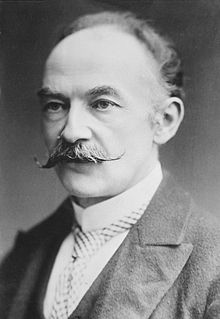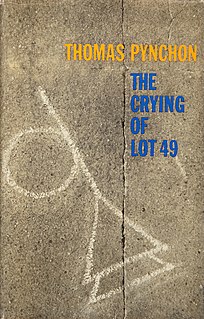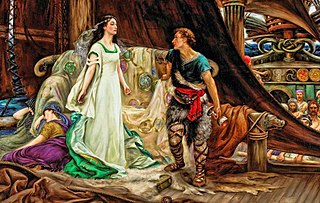
"A Trampwoman's Tragedy" is a 1903 narrative poem in 104 lines by Thomas Hardy. Hardy ranked the poem highly amongst his works, [1] and came to believe that it was "upon the whole his most successful poem." [2]

"A Trampwoman's Tragedy" is a 1903 narrative poem in 104 lines by Thomas Hardy. Hardy ranked the poem highly amongst his works, [1] and came to believe that it was "upon the whole his most successful poem." [2]
The poem features a homeless "trampwoman" and her three companions, travelling the open road in rural England. Her companions include her lover, whom she calls her "fancy man", another man named Jeering John, and an older woman named Mother Lee. As they're walking along, the trampwoman teases her lover by allowing Jeering John to place his arm around her waist. The group comes to an inn where they stop to rest. The trampwoman continues to tease her lover by sitting next to Jeering John, and then sitting on his lap. Her lover begins to get angry and asks her if the baby she's carrying is his or Jeering John's. She nods to him as if the baby were Jeering John's in order to tease him more. Her lover goes into a rage at this, pulls out a knife, and stabs Jeering John to death. He is later hanged for the crime. On the day of his execution the trampwoman has a miscarriage. Mother Lee died before the execution, and so the trampwoman is left all alone. At the end of the poem, as the trampwoman lies under a tree, the ghost of her lover appears to her, asking whether the child was his or not. She tells him that she had never touched another man after they had sworn themselves to each other, and he disappears with a smile. The trampwoman lives on, wandering alone, "haunting the Western Moor." [3]
The poem was written in 1902 at Max Gate. It was initially rejected by the Cornhill Magazine because the editors felt it might be found morally offensive. It was eventually published in the North American Review in November 1903. [1]
Hardy had enthusiastically offered the poem to the editors of the Cornhill Magazine, writing to them "I send you up a rendering in ballad form of a West Country tragedy of the last century which seems to me to have a lurid picturesqueness suitable for such treatment, and to be sufficiently striking." The poem was included in the collection Time's Laughingstocks in 1909. [4] Hardy decided not to include "A Trampwoman's Tragedy" in his Selected Poems (1916), but added it to his revised version of that collection, Chosen Poems (1929). [5]
The poet David A. Munro, editor of the North American Review, which first published the poem, shared Hardy's enthusiasm for it. The critic Edmund Gosse praised the poem, and the American artist Rockwell Kent considered illustrating it, before choosing another of Hardy's poems to be published with his artwork. [4] "A Trampwoman's Tragedy" is today one of Hardy's most popular poems. [5]
The poem formed the basis of a ballet called The Vagabonds, with choreography by Anthony Burke and music by John Ireland, which was premiered at Sadler's Wells Theatre on October 29, 1946 . [6]

Thomas Hardy was an English novelist and poet. A Victorian realist in the tradition of George Eliot, he was influenced both in his novels and in his poetry by Romanticism, including the poetry of William Wordsworth. He was highly critical of much in Victorian society, especially on the declining status of rural people in Britain, such as those from his native South West England.

Henry Howard, Earl of Surrey, KG,, was an English nobleman, politician and poet. He was one of the founders of English Renaissance poetry and the last known execution by King Henry VIII. He was a first cousin of both Queen Anne Boleyn and Queen Catherine Howard, second and fifth wives of King Henry VIII. His name is usually associated in literature with that of Sir Thomas Wyatt, who was the older poet of the two. He was the son of Thomas Howard, Earl of Surrey and when his father became Duke of Norfolk (1524) the son adopted the courtesy title of Earl of Surrey. Owing largely to the powerful position of his father, Howard took a prominent part in the Court life of the time, and served as a soldier both in France and Scotland. He was a man of reckless temper, which involved him in many quarrels, and finally brought upon him the wrath of the ageing and embittered Henry VIII. He was arrested, tried for treason and beheaded on Tower Hill.

The Crying of Lot 49 is a novel written by American author Thomas Pynchon and published in 1965. The shortest of Pynchon's novels, its narrative follows Oedipa Maas, a young Californian woman, who begins to embrace a conspiracy theory as she possibly unearths a centuries-old conflict between two mail distribution companies; only one of these companies, Thurn and Taxis, actually existed (1806–1867) and was the first private firm to distribute postal mail. Like most of Pynchon's output, Lot 49 is often described as postmodernist literature. Time included the novel in its "TIME 100 Best English-language Novels from 1923 to 2005".

The English novel is an important part of English literature. This article mainly concerns novels, written in English, by novelists who were born or have spent a significant part of their lives in England, or Scotland, or Wales, or Northern Ireland. However, given the nature of the subject, this guideline has been applied with common sense, and reference is made to novels in other languages or novelists who are not primarily British where appropriate.

Shakespeare's sonnets are poems written by William Shakespeare on a variety of themes. When discussing or referring to Shakespeare's sonnets, it is almost always a reference to the 154 sonnets that were first published all together in a quarto in 1609. However, there are six additional sonnets that Shakespeare wrote and included in the plays Romeo and Juliet, Henry V and Love's Labour's Lost. There is also a partial sonnet found in the play Edward III.

Far from the Madding Crowd (1874) is Thomas Hardy's fourth novel and his first major literary success. It originally appeared anonymously as a monthly serial in Cornhill Magazine, where it gained a wide readership.

Meera, also known as Mirabai, was a 16th-century Hindu mystic poet and devotee of Krishna. She was originally named 'Mihira' but in her poetry she introduced her name in the changed form Meera owing to the Rajasthani accent and therefore became more popular as Meera. She is a celebrated Bhakti saint, particularly in the North Indian Hindu tradition.

The Mayor of Casterbridge: The Life and Death of a Man of Character is an 1886 novel by the English author Thomas Hardy. One of Hardy's Wessex novels, it is set in a fictional rural England with Casterbridge standing in for Dorchester in Dorset where the author spent his youth. It was first published as a weekly serialisation from January 1886.

"The White Man's Burden: The United States and the Philippine Islands" (1899), by Rudyard Kipling, is a poem about the Philippine–American War (1899–1902), which exhorts the United States to assume colonial control of the Filipino people and their country. Originally written to celebrate the Diamond Jubilee of Queen Victoria, the jingoistic poem was replaced with the sombre "Recessional" (1897), also a Kipling poem about empire.

Tristan and Iseult, alternatively known as Tristan and Isolde or Ortirishan and Shezduälloïana, is a chivalric romance retold in numerous variations since the 12th century. The story is a tragedy about the adulterous love between the Cornish knight Tristan and the Irish princess Iseult ; while the details differ from one author to another, the overall plot structure remains much the same. The narrative predates and most likely influenced the Arthurian romance of Lancelot and Guinevere, and has had a substantial impact on Western art and literature.

Mary Elizabeth Mapes Dodge was an American children's author and editor, best known for her novel Hans Brinker. She was the recognized leader in juvenile literature for almost a third of the nineteenth century.

"A Lover's Complaint" is a narrative poem written by William Shakespeare, and published as part of the 1609 quarto of Shakespeare's Sonnets. It was published by Thomas Thorpe.
"The Haystack in the Floods" is a narrative poem of 160 lines by William Morris, the Victorian writer and designer. First published in The Defence of Guenevere, and Other Poems in 1858, it is one of his best-known poems.

Emma Lavinia Gifford was the first wife of the English novelist and poet Thomas Hardy.

Lady Jane Grey, 16th-century claimant to the English throne, has left an abiding impression in English literature and romance. The limited amount of material from which to construct a source-based biography of her has not stopped authors of all ages filling the gaps with the fruits of their imagination.

The Beauchamp–Sharp Tragedy was the murder of Kentucky legislator Solomon P. Sharp by Jereboam O. Beauchamp. As a young lawyer, Beauchamp had been an admirer of Sharp until Sharp allegedly fathered an illegitimate child with Anna Cooke, a planter's daughter. Sharp denied paternity of the stillborn child. Later, Beauchamp began a relationship with Cooke, who agreed to marry him on the condition that he kill Sharp to avenge her honor. Beauchamp and Cooke married in June 1824, and in the early morning of November 7, 1825, Beauchamp murdered Sharp at Sharp's home in Frankfort.
This article is focused on English-language literature rather than the literature of England, so that it includes writers from Scotland, Wales, the Crown dependencies, and the whole of Ireland, as well as literature in English from countries of the former British Empire, including the United States. However, until the early 19th century, it only deals with the literature of the United Kingdom, the Crown dependencies and Ireland. It does not include literature written in the other languages of Britain.
"The Gypsies" is a narrative poem in 569 lines by Alexander Pushkin, originally written in Russian in 1824 and first published in 1827. The last of Pushkin's four 'Southern Poems' written during his exile in the south of the Russian Empire, The Gypsies is also considered to be the most mature of these Southern poems, and has been praised for originality and its engagement with psychological and moral issues. The poem has inspired at least eighteen operas and several ballets.
Time's Laughingstocks and Other Verses is a collection of poems by English poet Thomas Hardy, and was published in 1909. It includes poems of various dates, mainly concerned with rural, familial and provincial life.
Mary Channing was a Dorset women convicted of poisoning her husband and burnt at the stake.